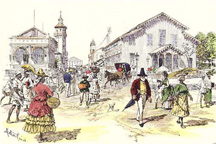How Georgetown got its streets
Kyk-Over-Al is one of this country’s oldest and most respected literary journals. Guyana Review reprints an interesting essay by Norman Cameron that was first published in Kyk-Over-Al, Vol. 2, No. 8, June 1949.
By N E Cameron
There is much to interest people about “our streets” even to the point of fascination. First, we may recall some difficulties over spelling. Is Cummings Street to be spelt with one or two m’s? The old street plaques carried three different spellings – one spelt with one m, the other with two m’s while both were spelt with an ‘s’ at the end; another with two m’s without the ‘s.’ Actually, the person who gave his name to Cummings Street and Cummingsburg was Thomas Cuming. Then there is Princes Street which some people call Princess Street, and Albouystown which is commonly spelt Albuoystown. Then there is the difference between Newmarket as one word and New Garden as two separate words.

To the visitor, two additional peculiarities stand out. One is that while “our streets” are very wide, often less than half of the width is utilized for traffic, the rest being wide green parapets, solely ornamental. The parapets provide a welcome relief of green but take the place of much-needed pavements.
The other is the number of canals or trenches which run through the town. These were far more numerous in the past. All of our avenues are filled-up trenches – East Street, Main Street, Carmichael Street, Hadfield, etc. The trenches are one of the features which remind us forcibly that almost all of Georgetown was once estate land, the cultivation being sugar or cotton. The trenches belong to the drainage system of the estate hence, also, some of the streets are still called “Dams.” Brickdam was the middle dam of an estate. Kelly’s Dam and Packwood Dam were “backdams” of estates. Company Path was a common dam between neighbouring estates. The railway lines were “company paths”.
Some of the streets bear the names of old estates or of their owners or attorneys, e.g., Vlissengen Road after Vlissengen Estate; Bourda Street named after a famous colonist, Mr Joseph Bourda.
While the division into wards helps us to form an idea of the growth of the town, yet some streets indicate former boundaries. Thus, North Street and East Street were evidently former limits to certain wards, and Middle Street would be the Middle Street of a ward from Lamaha Street to Church Street.
Forshaw Street is the only street in the city named after a coloured man. Forshaw was prominent in securing Queenstown from the proprietors of Pln. Bel Air and Council thought it fitting to name a street in that ward after him. A little history revealed that he was a very wealthy solicitor while his wife was a fine mulatto lady and they entertained in grand style, the Governor being a frequent visitor at his home.
Hadfield Street was named after the architect to whom we owe the Public Buildings; and Haley Street after the town planner to whom we owe much of the present layout of the city including the alley-ways for improved drainage.
The naming of the streets of Alberttown is interesting. Why are they named First Street, Second Street, and so on to Sixth Street and not after persons as in the case of the majority of our roads? The answer is that Alberttown was bought collectively some time after Emancipation and the owners settled in it as a village and named their streets in that way. A similar system was used in Lodge Village and Albouystown which were bought at about the same time.
A few of our streets are named to commemorate events. The Napoleonic wars caused a great deal of excitement here. Just as the last war was of vital interest to us as a German victory would have meant a change of nationality, so a French victory in 1815 would have meant that the Colony, which had already been previously owned by the Dutch and French, would have experienced some more changing of hands. Hence, the British victory is commemorated here in the names Waterloo and Wellington Streets.
Suppose you were to ask why was Breda Street so named? It was to commemorate the Peace of Breda in 1667. Surinam was at that time owned by the English and as English and the Dutch were at war, there was a lively attack by the English colonists of Surinam on the Dutch of Essequibo, Berbice and Demerara. The Peace of Breda was made at the end of this war and, it is good to remember that by this peace of Breda, Surinam passed to the Dutch while the Dutch handed over to the English the city which later became known as New York.
